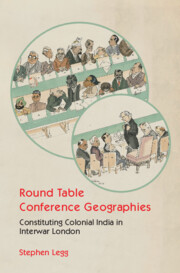Book contents
- Frontmatter
- Contents
- List of Figures and Tables
- Acknowledgements
- Note on Conversions, Spellings and Abbreviations
- 1 Introduction: Squaring Round Tables
- Part I Geographical Imaginations
- Part II Conference Infrastructures
- Part III The Conference City
- Part IV Representations
- Notes
- References
- Index
- Miscellaneous Endmatter
1 - Introduction: Squaring Round Tables
Published online by Cambridge University Press: 15 January 2023
- Frontmatter
- Contents
- List of Figures and Tables
- Acknowledgements
- Note on Conversions, Spellings and Abbreviations
- 1 Introduction: Squaring Round Tables
- Part I Geographical Imaginations
- Part II Conference Infrastructures
- Part III The Conference City
- Part IV Representations
- Notes
- References
- Index
- Miscellaneous Endmatter
Summary
On 12 November 1930 King-Emperor George V inaugurated the Round Table Conference (RTC) in the Royal Gallery of the Palace of Westminster. The Illustrated Weekly of India noted his awareness that the British Commonwealth itself depended on the constitutional debates over India’s future that would take place in the imperial capital. The article also carried a special cartoon by Mrs E. King featuring some notable personalities at the conference (see Figure 1.1). From the turbaned Maharaja of Bikaner, a prominent ruler of the hereditary Indian (or ‘princely’) states, at the top left, the reader’s gaze was directed clockwise around the table. Here awaited caricatures including the leading liberal Sir Tej Bahadur Sapru, the Muslim politician M. A. Jinnah, the ex-viceroy Lord Reading, the Maharaja of Patiala, the former law member for the Government of India Sir Muhammed Shafi, the wealthy leader of the Ismaili sect of the Shia Muslim community and chairman of the non-princely, British Indian delegates, the Aga Khan, and Governor of the United Provinces and conference advisor Sir Malcolm Hailey.
Most remarkable are the depictions above and within the circle of conference attendees. Floating above the table are the ghosts at the feast: in from the left waft M. K. Gandhi and V. J. Patel, and from the right Pandits Jawaharlal and Motilal Nehru. These leaders of the Indian National Congress (‘Congress’) had not only refused to come to London but also launched the civil disobedience movement in response to Britain’s failure to confirm the conference’s purpose as that of granting India ‘Dominion status’ (Moore 1974, 97–99). Viceroy Irwin had insisted this was because it was to be a free conference with no set agenda or outcomes. In this belated commitment to liberal free speech, Congress saw yet more dilatory tactics from a colonial government desperately trying to stem the advance of anti-colonial nationalism. The absence of Congress haunted the preparations for the conference and cast a pall over the opening ceremony. When the plenary sessions began five days later in St James’s Palace, however, something remarkable happened. In the opening addresses, first Sapru and then Bikaner came out in favour of an all-India federation, uniting the separate sovereign patchworks of princely and British India.
- Type
- Chapter
- Information
- Round Table Conference GeographiesConstituting Colonial India in Interwar London, pp. 1 - 34Publisher: Cambridge University PressPrint publication year: 2023



